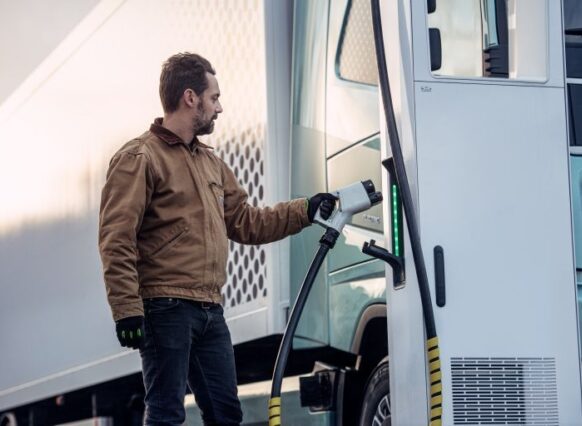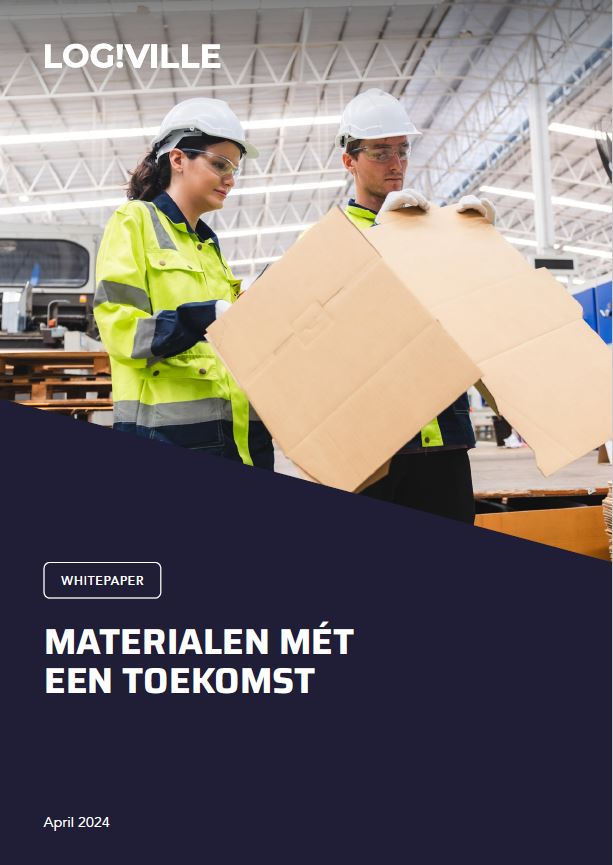
Europe seeks to make road transport emission-free as quickly as possible. Its ambitions are incredibly high. It all seems to be achievable from a technological perspective, but electric vehicles require a completely different ecosystem, which is presenting great challenges to numerous stakeholders. They are facing an uphill struggle and problems that must be resolved at lightning speed.
Last year, the number of heavy electric vehicles (+16 tons) on the roads in Europe increased more rapidly than ever before. A total of 1,041 e-trucks were sold, an increase of around 200%, but Belgium is falling behind, with just 20 electric trucks. By comparison, around 7,400 heavy vehicles were registered for diesel and 155 for CNG/LNG in our country. The European countries with the highest number of registered electric trucks are Switzerland, Norway, Sweden and the Netherlands and across Europe, around 99% of the total fleet is driven by diesel. There is clearly a long way to go before this fleet becomes emission-free. That is exactly why the European Commission published its ambitious aims in February. If it is up to Europe, CO2 norms for new heavy vehicles must gradually but drastically be tightened. By 2030, CO2 emissions must be reduced by 45%; by 2035, this reduction must reach -65% and by 2040, it must be -90%. Almost all new trucks that are sold must be emission-free by then but there will be certain exceptions for agricultural vehicles, fire trucks and the like.
These ambitions are exceptionally high but, at first glance, are certainly achievable. The figures from Eurostat show that it would already be possible to electrify almost half of all transport, as almost half (45%) of all goods that are transported by road in Europe cover a distance of under 300 km. With smart route planning and schedules, much of this cargo could be transported using electric vehicles, with the emphasis on ‘could’.
Very ambitious goals
The European Commission is stressing the various technological options. European truck producers already have e-trucks in their ranges which cover many of the corresponding needs and their production equipment is also being adapted incredibly quickly. Nevertheless, the chairman of the umbrella organisation for truck producers, the ACEA, and CEO of Volvo Group, Martin Lundstedt believes that the proposed goal of a CO2 reduction of 45% by 2030 is ‘exceptionally ambitious’. It means that, by that time, there must be over 400,000 (!) emission-free trucks on the roads, and that at least 100,000 new emission-free trucks must be registered every year. ‘This will also be an ambitious project for policy-makers, who must ensure that the various other players in the transport and logistics sectors deliver similar performances in the value chain at the same time,’ he explains.
Sven Geysels, who leads the Logibat project with Aldo Peeters endorses this. In the context of this project, they research the operational and economic conditions for making battery-electric transport viable. Logibat’s advice for transport companies? ‘Brace yourselves because a tsunami of challenges is coming your way,’ he adds. ‘Electric driving also means that ecosystems will change, with different insurance policies, different skills, alternative management systems, other methods for dealing with customers, and so on.’
Aldo Peeters: ‘There is a growing awareness among transporters but this is still in its infancy. A few of them have already understood the situation and can be called pioneers. Then there are the early adopters. And then you have the majority of the sector.’ Many transporters will have to face a deafening wake-up call when they realise the fast pace at which Europe is aiming to decarbonise road transport.
Technology evolving at lightning speed
‘The designers have been doing their homework. In just a few years, the driving range has increased from 200 to 400 km, electric tractors are now on the market alongside trailers and almost every sector of the transport market is now covered. In the Netherlands, 50-ton lorries are already using electric power and, in Sweden, they have 74-ton trucks. Things are moving quickly,’ explains Aldo Peeters.
‘Battery-electric trucks are ready to take to the roads in greater numbers and electric trucks running on fuel cells will follow soon after,’ says Martin Lundstedt. ‘The will and the capacity of transport companies to invest in emission-free trucks, however, is directly related to the availability of the charging and fuelling infrastructure. And unfortunately, that is almost entirely lacking at the moment.’
‘It is very simple; transporters will not buy battery-electric trucks if they cannot be charged to ensure smooth and seamless functioning,’ he warns.
Charging infrastructure on the way
But action is being taken here too, both by the European Commission and the private sector.
The Commission has previously published a plan to accelerate the roll-out of charging stations, which was approved on 28 March by the European Council and European Parliament. Among other things, this Alternative Fuel Infrastructure Regulation (AFIR) sets out the requirements that the charging infrastructure for heavy trucks (and the fuelling infrastructure for hydrogen in the future) must fulfil.
This means that, along the European TEN-T motorways, there must be a quick charging network for e-trucks every 120 km, where they can pay to use a charging point using a payment card. The roll-out must begin by 2025. By the end of that year, 15% of the total length of the TEN-T-network, at 120 km intervals, must have had the infrastructure for trucks installed. After 2025, this distance will be reduced to 60 km on the core network and 100 km on the extended network. The entire network must be completed by 2030. From 2028, safe and secure parking areas must offer at least two charging stations for trucks. By 2031, fuel stations for hydrogen must be installed at a minimum of 200 km intervals.
According to the agreement, every EU member state must commit to a mandatory minimum infrastructure goal and then present the European Commission with a step-by-step plan on how this will be rolled out.
The private sector, specifically the constructors, is also getting down to work. The Volvo Group (Volvo/Renault Trucks), Traton (Scania/MAN) and Daimler (Mercedes-Benz) have set up a joint venture to install at least 1,700 charging points and operate them in the vicinity of motorways and logistics hubs in Europe. They will invest at least 500 million euros in this project.
After gathering and analysing GPS coordinates from around 400,000 vehicles that are active across Europe, ACEA has identified more than 40,000 locations that are suitable for charging stations. This data is being made available to support the creation of a network across the EU region.
Insurance companies and support services
‘Other sectors in society must also emerge and start adapting to the new ecosystem. Insurers, for example, must cover trucks that are worth three times the catalogue value and give rise to new types of risk. This is a great challenge for them, as they must take steps without having the relevant statistics, which are not yet available,’ explains Aldo Peeters.
‘The emergency services must also implement changes and be able to respond to situations and hazards they are not yet familiar with. In the context of Logibat, therefore, we have formulated recommendations for the FPS Foreign Affairs on how the emergency services must respond in the event of disasters. We have looked at this in great detail,’ he adds.
‘The challenges facing other stakeholders are also significant. This includes energy suppliers, of course, but also IT companies, the customers of transport companies, and so on,’ Sven Geysels adds.
Online TCO calculation tool
With the opening of every new charging station, the options for using electric trucks will increase exponentially. Scale benefits and technological developments will, in turn, lead to the necessary improvements in the Total Cost of Ownership (TCO) for e-trucks.
‘The story, however, is somewhat more complex than just the TCO. We must establish which applications are eligible for the current generation of vehicles and then check which applications provide the best TCO and develop a charging strategy for these applications. Within the Logibat project, the professional group MOBI from the VUB has built an online TCO calculation tool which allows the user to make economic comparisons of conventional trucks with battery-electric trucks across a wide range of applications,’ Sven Geysels says.
Two messages
Aldo Peeters and Sven Geysels do not want to comment on the results of the Logibat project; they are keeping the verdict until the closing event at Log!Ville on 20 April. But they have two messages for those willing to listen.
‘The first is that transporters must overcome their reticence and get on board in good time. By the end of this decade, the TCO for an electric truck will be similar to that of a diesel truck. CO2 pricing and the evolution of battery technology will only increase the speed of the transition. So start the journey now and gain experience,’ Aldo Peeters says.
‘The second message is targeted towards the various stakeholders who need to start talking to one another. The electrification of road transport will fundamentally influence various sectors and they will all benefit from talking and sharing information. This conversation will, in turn, give them greater insights into the opportunities of tomorrow. The use of trucks, for example, will fundamentally change and this will impact warehouses, which will also have to adapt to e-mobility. And warehouses are certainly not the only stakeholders that will have to make adjustments,’ concludes Sven Geysels.

Photo: Copyright Volvo Trucks



